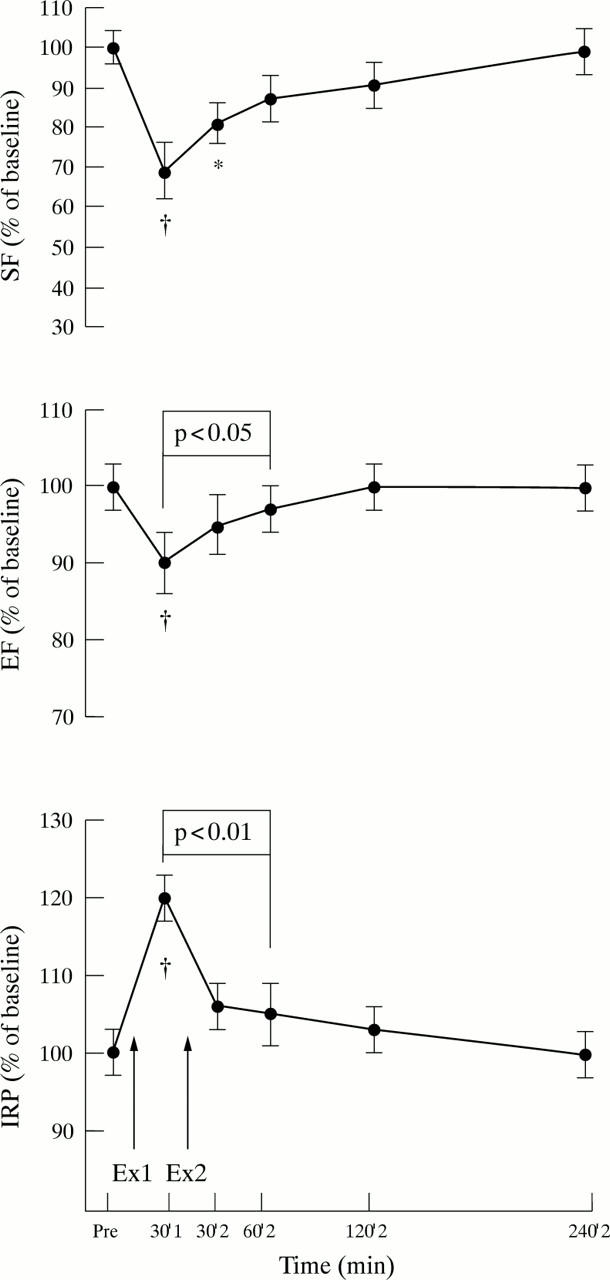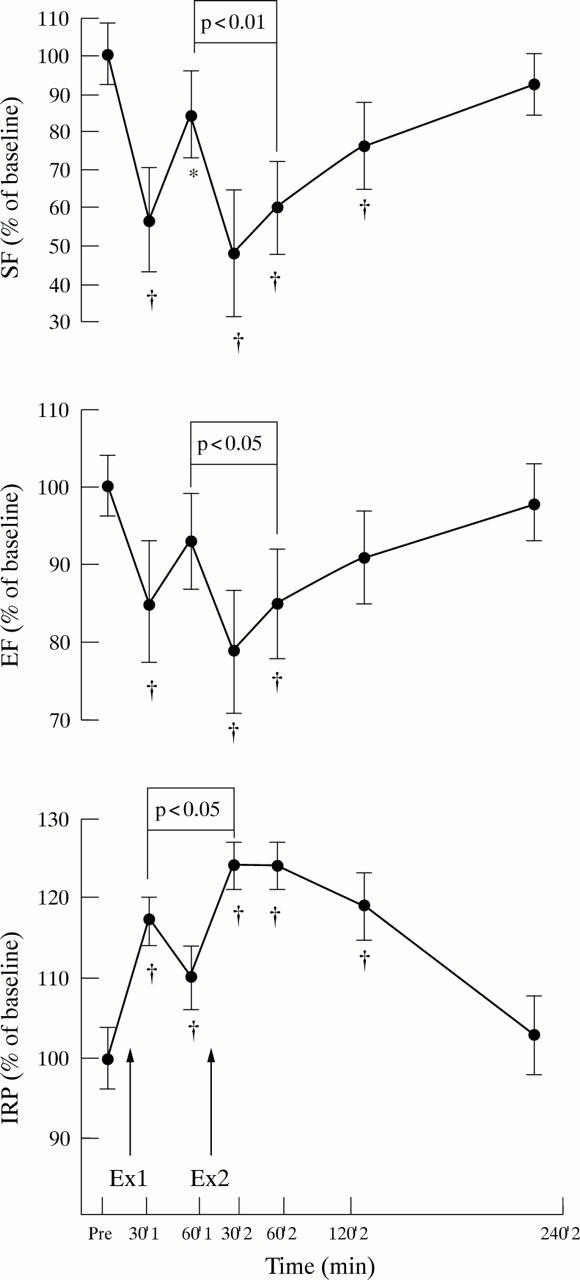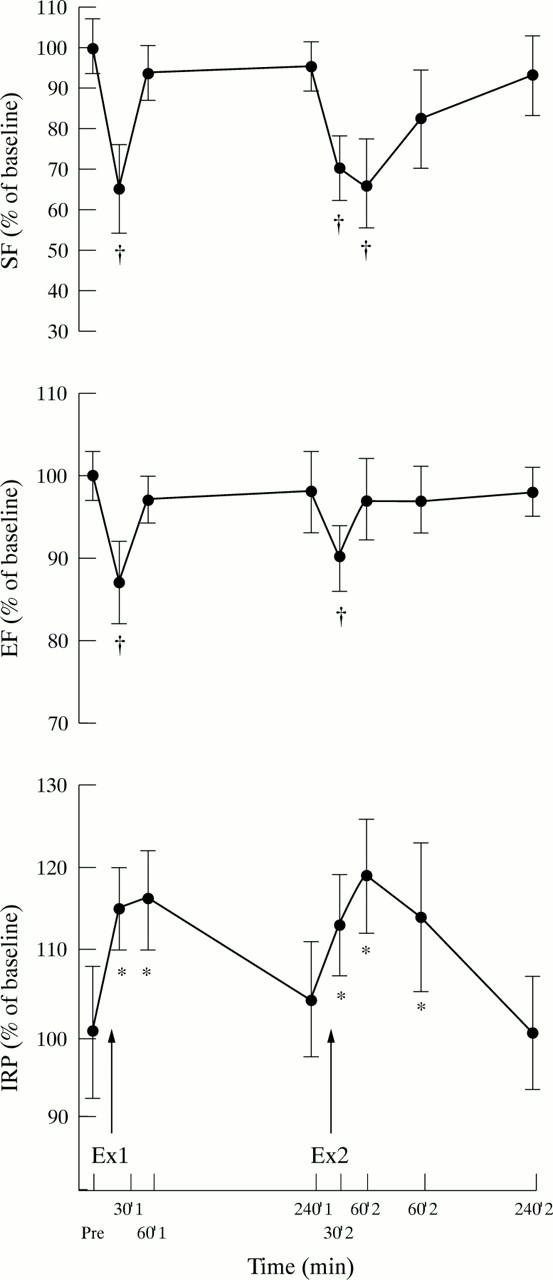Abstract
BACKGROUND—Myocardial stunning is known to occur following a single episode of effort angina in patients with coronary artery disease. The effect on left ventricular (LV) function of repeated episodes of ischaemia is unknown. OBJECTIVES—To investigate the effects of repeated episodes of exercise induced ischaemia on LV function in patients with chronic stable angina. METHODS—Patients with significant coronary artery disease and normal LV function underwent two episodes of symptom limited treadmill exercise separated by three different time intervals: either 30 minutes (group A, n = 14); 60 minutes (group B, n = 14); or 240 minutes (group C, n = 14). Quantitative stress echocardiography was performed at repeated intervals between the two exercises and for 240 minutes following the second test. RESULTS—For all groups there was no difference between the degree of ischaemia judged by maximal ST depression during the two tests. All episodes of exercise induced ischaemia produced prolonged abnormalities of LV systolic and diastolic function despite rapid normalisation of haemodynamic and ECG changes. In group A (30 minutes) these abnormalities were less pronounced after the second test than after the first, while in group B (60 minutes) they were more severe and long lasting. In group C (240 minutes) the two tests produced similar abnormalities of LV function. CONCLUSIONS—Prolonged abnormalities of LV function occurred following exercise induced ischaemia with a time course consistent with myocardial stunning. The severity and degree of LV dysfunction caused by a further episode of ischaemia appear to be dependent on the time interval between ischaemic episodes. Keywords: ventricular function; exercise; stress echocardiography
Full Text
The Full Text of this article is available as a PDF (142.2 KB).
Figure 1 .

Echocardiographic parameters for 13 of 14 patients in group A (30 minutes) who exhibited prolonged wall motion abnormalities (WMAs) following exercise. Data are expressed as the percentage change from baseline values (mean (SE)). SF, shortening fraction (%) (refers to SF in the segments exhibiting wall motion abnormalities—that is, SFwma); EF, ejection fraction (%); IRP, isovolumic relaxation period (ms); Ex1, exercise 1; Ex2, exercise 2 *p < 0.05; †p < 0.001 versus pre Ex1.
Figure 2 .

Echocardiographic parameters for 11 of 14 patients in group B (60 minutes) who exhibited prolonged WMAs following exercise. Data are expressed as the percentage change from baseline values (mean (SE)). *p < 0.05; †p < 0.001 versus pre Ex1.
Figure 3 .

Echocardiographic parameters for 11 of 14 patients in group C (240 minutes) who exhibited prolonged WMAs following exercise. Data are expressed as the percentage change from baseline values (mean (SE)). *p < 0.05; †p < 0.001 versus pre Ex1.
Selected References
These references are in PubMed. This may not be the complete list of references from this article.
- Ambrosio G., Betocchi S., Pace L., Losi M. A., Perrone-Filardi P., Soricelli A., Piscione F., Taube J., Squame F., Salvatore M. Prolonged impairment of regional contractile function after resolution of exercise-induced angina. Evidence of myocardial stunning in patients with coronary artery disease. Circulation. 1996 Nov 15;94(10):2455–2464. doi: 10.1161/01.cir.94.10.2455. [DOI] [PubMed] [Google Scholar]
- Assmann P. E., Slager C. J., van der Borden S. G., Dreysse S. T., Tijssen J. G., Sutherland G. R., Roelandt J. R. Quantitative echocardiographic analysis of global and regional left ventricular function: a problem revisited. J Am Soc Echocardiogr. 1990 Nov-Dec;3(6):478–487. doi: 10.1016/s0894-7317(14)80364-7. [DOI] [PubMed] [Google Scholar]
- Baxter G. F., Marber M. S., Patel V. C., Yellon D. M. Adenosine receptor involvement in a delayed phase of myocardial protection 24 hours after ischemic preconditioning. Circulation. 1994 Dec;90(6):2993–3000. doi: 10.1161/01.cir.90.6.2993. [DOI] [PubMed] [Google Scholar]
- Becker L. C. Do neutrophils contribute to myocardial stunning? Cardiovasc Drugs Ther. 1991 Oct;5(5):909–913. doi: 10.1007/BF00053552. [DOI] [PubMed] [Google Scholar]
- Bland J. M., Altman D. G. Statistical methods for assessing agreement between two methods of clinical measurement. Lancet. 1986 Feb 8;1(8476):307–310. [PubMed] [Google Scholar]
- Bolli R. Myocardial 'stunning' in man. Circulation. 1992 Dec;86(6):1671–1691. doi: 10.1161/01.cir.86.6.1671. [DOI] [PubMed] [Google Scholar]
- Downey J. M., Liu G. S., Thornton J. D. Adenosine and the anti-infarct effects of preconditioning. Cardiovasc Res. 1993 Jan;27(1):3–8. doi: 10.1093/cvr/27.1.3. [DOI] [PubMed] [Google Scholar]
- Geft I. L., Fishbein M. C., Ninomiya K., Hashida J., Chaux E., Yano J., Y-Rit J., Genov T., Shell W., Ganz W. Intermittent brief periods of ischemia have a cumulative effect and may cause myocardial necrosis. Circulation. 1982 Dec;66(6):1150–1153. doi: 10.1161/01.cir.66.6.1150. [DOI] [PubMed] [Google Scholar]
- Gottlieb S. O., Weisfeldt M. L., Ouyang P., Mellits E. D., Gerstenblith G. Silent ischemia as a marker for early unfavorable outcomes in patients with unstable angina. N Engl J Med. 1986 May 8;314(19):1214–1219. doi: 10.1056/NEJM198605083141903. [DOI] [PubMed] [Google Scholar]
- Homans D. C., Laxson D. D., Sublett E., Lindstrom P., Bache R. J. Cumulative deterioration of myocardial function after repeated episodes of exercise-induced ischemia. Am J Physiol. 1989 May;256(5 Pt 2):H1462–H1471. doi: 10.1152/ajpheart.1989.256.5.H1462. [DOI] [PubMed] [Google Scholar]
- Lasley R. D., Anderson G. M., Mentzer R. M., Jr Ischaemic and hypoxic preconditioning enhance postischaemic recovery of function in the rat heart. Cardiovasc Res. 1993 Apr;27(4):565–570. doi: 10.1093/cvr/27.4.565. [DOI] [PubMed] [Google Scholar]
- Lawson C. S., Avkiran M., Shattock M. J., Coltart D. J., Hearse D. J. Preconditioning and reperfusion arrhythmias in the isolated rat heart: true protection or temporal shift in vulnerability? Cardiovasc Res. 1993 Dec;27(12):2274–2281. doi: 10.1093/cvr/27.12.2274. [DOI] [PubMed] [Google Scholar]
- Lawson C. S., Coltart D. J., Hearse D. J. "Dose"-dependency and temporal characteristics of protection by ischaemic preconditioning against ischaemia-induced arrhythmias in rat hearts. J Mol Cell Cardiol. 1993 Dec;25(12):1391–1402. doi: 10.1006/jmcc.1993.1156. [DOI] [PubMed] [Google Scholar]
- Lawson C. S., Downey J. M. Preconditioning: state of the art myocardial protection. Cardiovasc Res. 1993 Apr;27(4):542–550. doi: 10.1093/cvr/27.4.542. [DOI] [PubMed] [Google Scholar]
- Li Y., Kloner R. A. Cardioprotective effects of ischaemic preconditioning are not mediated by prostanoids. Cardiovasc Res. 1992 Mar;26(3):226–231. doi: 10.1093/cvr/26.3.226. [DOI] [PubMed] [Google Scholar]
- Marber M. S., Joy M. D., Yellon D. M. Is warm-up in angina ischaemic preconditioning? Br Heart J. 1994 Sep;72(3):213–215. doi: 10.1136/hrt.72.3.213. [DOI] [PMC free article] [PubMed] [Google Scholar]
- Marinho N. V., Keogh B. E., Costa D. C., Lammerstma A. A., Ell P. J., Camici P. G. Pathophysiology of chronic left ventricular dysfunction. New insights from the measurement of absolute myocardial blood flow and glucose utilization. Circulation. 1996 Feb 15;93(4):737–744. doi: 10.1161/01.cir.93.4.737. [DOI] [PubMed] [Google Scholar]
- McGillem M. J., Mancini G. B., DeBoe S. F., Buda A. J. Modification of the centerline method for assessment of echocardiographic wall thickening and motion: a comparison with areas of risk. J Am Coll Cardiol. 1988 Apr;11(4):861–866. doi: 10.1016/0735-1097(88)90223-9. [DOI] [PubMed] [Google Scholar]
- Miyamae M., Fujiwara H., Kida M., Yokota R., Tanaka M., Katsuragawa M., Hasegawa K., Ohura M., Koga K., Yabuuchi Y. Preconditioning improves energy metabolism during reperfusion but does not attenuate myocardial stunning in porcine hearts. Circulation. 1993 Jul;88(1):223–234. doi: 10.1161/01.cir.88.1.223. [DOI] [PubMed] [Google Scholar]
- Murry C. E., Jennings R. B., Reimer K. A. Preconditioning with ischemia: a delay of lethal cell injury in ischemic myocardium. Circulation. 1986 Nov;74(5):1124–1136. doi: 10.1161/01.cir.74.5.1124. [DOI] [PubMed] [Google Scholar]
- Nicklas J. M., Becker L. C., Bulkley B. H. Effects of repeated brief coronary occlusion on regional left ventricular function and dimension in dogs. Am J Cardiol. 1985 Sep 1;56(7):473–478. doi: 10.1016/0002-9149(85)90889-6. [DOI] [PubMed] [Google Scholar]
- Ovize M., Przyklenk K., Hale S. L., Kloner R. A. Preconditioning does not attenuate myocardial stunning. Circulation. 1992 Jun;85(6):2247–2254. doi: 10.1161/01.cir.85.6.2247. [DOI] [PubMed] [Google Scholar]
- Rahimtoola S. H. The hibernating myocardium. Am Heart J. 1989 Jan;117(1):211–221. doi: 10.1016/0002-8703(89)90685-6. [DOI] [PubMed] [Google Scholar]
- Sheehan F. H., Bolson E. L., Dodge H. T., Mathey D. G., Schofer J., Woo H. W. Advantages and applications of the centerline method for characterizing regional ventricular function. Circulation. 1986 Aug;74(2):293–305. doi: 10.1161/01.cir.74.2.293. [DOI] [PubMed] [Google Scholar]
- Shen Y. T., Vatner S. F. Mechanism of impaired myocardial function during progressive coronary stenosis in conscious pigs. Hibernation versus stunning? Circ Res. 1995 Mar;76(3):479–488. doi: 10.1161/01.res.76.3.479. [DOI] [PubMed] [Google Scholar]
- Shiki K., Hearse D. J. Preconditioning of ischemic myocardium: reperfusion-induced arrhythmias. Am J Physiol. 1987 Dec;253(6 Pt 2):H1470–H1476. doi: 10.1152/ajpheart.1987.253.6.H1470. [DOI] [PubMed] [Google Scholar]
- Stewart R. A., Simmonds M. B., Williams M. J. Time course of "warm-up" in stable angina. Am J Cardiol. 1995 Jul 1;76(1):70–73. doi: 10.1016/s0002-9149(99)80804-2. [DOI] [PubMed] [Google Scholar]
- Tillisch J., Brunken R., Marshall R., Schwaiger M., Mandelkern M., Phelps M., Schelbert H. Reversibility of cardiac wall-motion abnormalities predicted by positron tomography. N Engl J Med. 1986 Apr 3;314(14):884–888. doi: 10.1056/NEJM198604033141405. [DOI] [PubMed] [Google Scholar]
- Urabe K., Miura T., Iwamoto T., Ogawa T., Goto M., Sakamoto J., Iimura O. Preconditioning enhances myocardial resistance to postischaemic myocardial stunning via adenosine receptor activation. Cardiovasc Res. 1993 Apr;27(4):657–662. doi: 10.1093/cvr/27.4.657. [DOI] [PubMed] [Google Scholar]
- Vanoverschelde J. L., Wijns W., Depré C., Essamri B., Heyndrickx G. R., Borgers M., Bol A., Melin J. A. Mechanisms of chronic regional postischemic dysfunction in humans. New insights from the study of noninfarcted collateral-dependent myocardium. Circulation. 1993 May;87(5):1513–1523. doi: 10.1161/01.cir.87.5.1513. [DOI] [PubMed] [Google Scholar]


